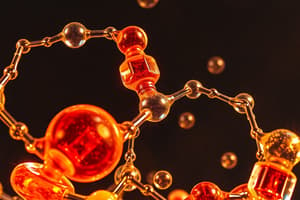Podcast
Questions and Answers
The parallel chains are then held together by many ______ bonds, and the sheer number of ______ bonds provides strength.
The parallel chains are then held together by many ______ bonds, and the sheer number of ______ bonds provides strength.
hydrogen
Monomers join together by ______ reactions to make polymers.
Monomers join together by ______ reactions to make polymers.
condensation
Glucose, galactose and ______ are the three monosaccharides you need to know.
Glucose, galactose and ______ are the three monosaccharides you need to know.
fructose
Cellulose is for ______ strength in plants.
Cellulose is for ______ strength in plants.
Glycogen is for ______ storage in animals.
Glycogen is for ______ storage in animals.
Starch is for ______ storage in plants.
Starch is for ______ storage in plants.
There are three key ______ that you need to remember, and these are made from the three key monosaccharides you learned.
There are three key ______ that you need to remember, and these are made from the three key monosaccharides you learned.
A ______ reaction creates a disaccharide.
A ______ reaction creates a disaccharide.
The bond that forms is known as a ______ bond (highlighted in blue).
The bond that forms is known as a ______ bond (highlighted in blue).
______ can be broken down back into monosaccharides via a hydrolysis reaction.
______ can be broken down back into monosaccharides via a hydrolysis reaction.
______ is found in plants, not in animal cells, and it is the major carbohydrate store.
______ is found in plants, not in animal cells, and it is the major carbohydrate store.
Cellulose provides ______ support.
Cellulose provides ______ support.
Hydrogen bonds form between different water molecules between the oxygen and a ______ atom.
Hydrogen bonds form between different water molecules between the oxygen and a ______ atom.
Water is a ______ solvent, meaning many substances dissolve in it.
Water is a ______ solvent, meaning many substances dissolve in it.
The slight positive charge on ______ atoms will attract any negative ions in solutes.
The slight positive charge on ______ atoms will attract any negative ions in solutes.
Water is involved in many reactions, such as ______, hydrolysis, and condensation reactions.
Water is involved in many reactions, such as ______, hydrolysis, and condensation reactions.
Water has a high ______ capacity, and it buffers temperature.
Water has a high ______ capacity, and it buffers temperature.
Polar molecules are often described as ______, meaning they are attracted to water.
Polar molecules are often described as ______, meaning they are attracted to water.
Monosaccharides are ______ and are soluble in water.
Monosaccharides are ______ and are soluble in water.
All carbohydrates contain three ______: carbon, hydrogen and oxygen.
All carbohydrates contain three ______: carbon, hydrogen and oxygen.
Glucose is a ______ monosaccharide that can provide energy or be polymerised to form a structural support molecule.
Glucose is a ______ monosaccharide that can provide energy or be polymerised to form a structural support molecule.
Isomers are compounds that have the same ______, but the atoms are arranged differently.
Isomers are compounds that have the same ______, but the atoms are arranged differently.
Disaccharides are two monosaccharides bonded together by a ______ bond.
Disaccharides are two monosaccharides bonded together by a ______ bond.
The bond that is formed by a condensation reaction is called a ______ bond.
The bond that is formed by a condensation reaction is called a ______ bond.
Non-polar molecules, such as ______, cannot dissolve in water and are therefore described as hydrophobic.
Non-polar molecules, such as ______, cannot dissolve in water and are therefore described as hydrophobic.
The fact that many essential polar substances dissolve in water enables them to be transported easily around ______ and plants through blood or xylem.
The fact that many essential polar substances dissolve in water enables them to be transported easily around ______ and plants through blood or xylem.
This means that a lot of energy is required to raise the temperature of the ______ because some of the heat energy is used to break the hydrogen bonds between ______ molecules.
This means that a lot of energy is required to raise the temperature of the ______ because some of the heat energy is used to break the hydrogen bonds between ______ molecules.
This provides a stable environment, in terms of temperature, for ______ organisms.
This provides a stable environment, in terms of temperature, for ______ organisms.
The ______ heat of vaporisation of water means that a lot of energy is required to convert water in its liquid state to a gaseous state.
The ______ heat of vaporisation of water means that a lot of energy is required to convert water in its liquid state to a gaseous state.
Enzymes do not ______ or reduce activity with temperature fluctuations due to the high specific heat capacity of water.
Enzymes do not ______ or reduce activity with temperature fluctuations due to the high specific heat capacity of water.
Flashcards are hidden until you start studying




